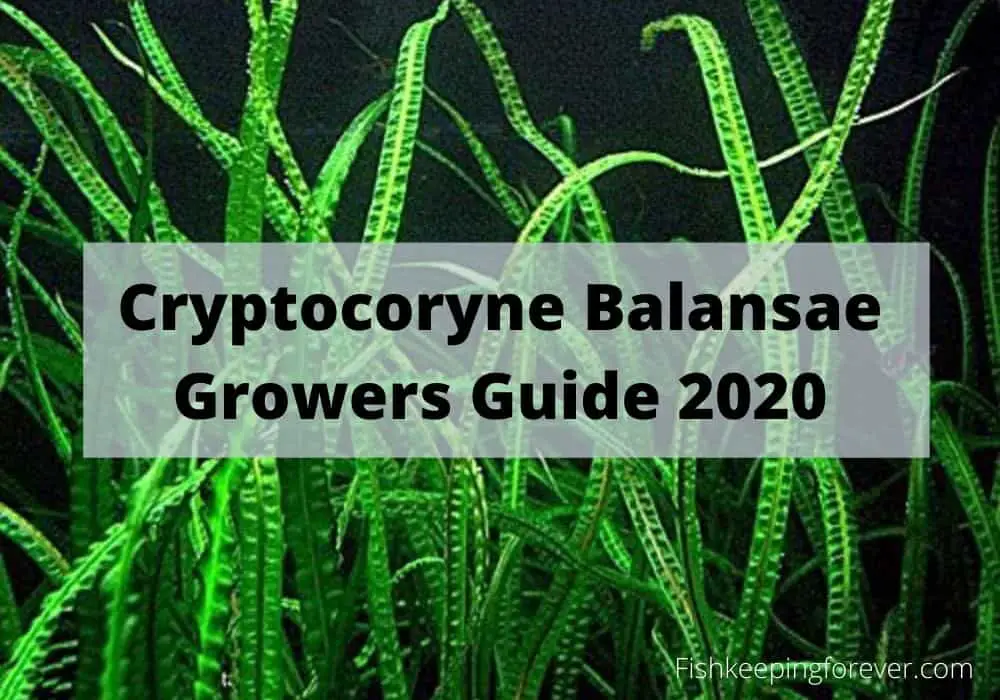From the aquatic family Araceae, Cryptocoryne Balansae is one of the most popular and long-lasting aquarium plants. It is found naturally distributed in tropical regions of India, Southeast Asia, and New Guinea where it thrives in streams and large rivers. It may also be found seasonally in forest pools and on riverbanks where it only becomes submerged at night.
Table of Contents
Useful Information
Scientific Name – Cryptocoryne Balansae
Family – Araceae
Maximum Size – 30 to 55 centimeters (11.81 – 21.65 inches)
pH Range – 6.8 to 7.5
Water Hardness – dGH 4 to 8
Water Temperature – 24 to 28 C (75.2 – 82.4 F)
Reproduction – Runners
Origin – East Asia
Growth Rate – Normal/Average
Substrate Requirements – Rocky
Lighting Needs – Medium
Aquarium Placement – Middle ground, background

Cryptocoryne Balansae Description
Reaching between 30 and 55 centimeters in height the Cryptocoryne Balansae is an imposing and large species of aquatic plant. It has long strap-like leaves that are around an inch in width that have rippled or hammered patternization. Coloration is usually a luscious green but some may take on a bronze hue. They are commonly used as a background plant due to their being quite tall.
How To Care For Cryptocoryne Balansae
When it comes to caring for Cryptocoryne there is very little to it as they more or less just need a stable environment. They are best kept submerged though they can also, like other Crypt species, be kept immersed as this is how they will thrive best.
If you want to keep them immersed, however, the best way to do this is to plant them in a substrate with two inches of water above. This way the leaves will grow into the water and any inflorescences will grow straight up.
You can also house Cryptocoryne Balansae in outdoor ponds as long as you pot them in a heavy container and place in one to two feet of water. Be aware, however, Koi and Goldfish may find this species of plant a tasty treat so you’ll need to be careful.
Lighting requirements would be moderate to high with good lighting developing the most attractive puckering of the leaves. Be careful, however, as too high lighting can cause ‘Crypt Melt.’
Cryptocoryne Balansae should also be planted in substrate due to being root feeders. Occasional supplements will aid in growth, as will regular water column fertilization. Try not to move this plant once you have it settled in a spot as it will not react well and may develop ‘Crypt Melt.’
What is Crypt Melt?
Crypt Melt is a condition often experienced when planting new Cryptocoryne species in your aquarium. It shows itself in the shape of the plant losing its leaves. There are a few possible causes for this occurring within your aquarium and they are as follows.
Rapid environmental change can cause Crypt Melt such as moving your plant from one spot to another or changes in water quality. Cryptocoryne Balansae needs up to thirty days to establish itself in an aquarium and for its leaves to grow.
See our recommendations for the Best Aquarium Plant Substrate here!
It is better to only plant this species in an aquarium that has been running for a minimum of three months.
In its natural habitat, Cryptocoryne Balansae grows mainly fully submerged in the water. In plant nurseries, however, it is often grown immersed instead. Crypt Melt can occur when the transition is made from immersive to submerged due to this plant not thriving on change.
Finally, Crypt Melt can occur when the nitrates in aquarium water become too high. Regular water changes and monitoring of water quality is imperative to prevent this from happening.
Cryptocoryne Balansae Reproduction
The reproduction of this species is through runners and tubular inflorescences with well-established plants having the best chance of flowering. This plant will need regular trimming to stop it from outgrowing its intended area.
This is easily done using a razor blade or sharp scissors. Cutting through the substrate just like one edges a lawn is often the best method to use. Specialist tool kits are sold that contain all the tools you’ll need to keep your aquarium plants looking trimmed and correct.
Aquascaping The Cryptocoryne Balansae
Due to its potential size, Cryptocoryne Balansae is best used as a background aquarium especially if your tank is on the small side. It needs a depth of around 18 inches unless you want the leaves to float on the surface. Beware, however, if you choose to go with floating foliage as it can cause shadows and shade any plants growing below.
This plant is often used in aquascaped aquariums to recreate that local river or Amazon look.
Cryptocoryne Balansae looks great either as a focal group or in a tight grouping. This is due to its long strap-like leaves making quite the statement and providing contrast to broad-leaved plants and hardscape items.
Benefits Of Having Cryptocoryne Balansae
We love this plant for its attractive long and thin wavy leaves, its versatility, excellent coverage, and the fact that it is something a little bit different. But, it is not only these factors you should be taking into account. Cryptocoryne Balansae also has some practical benefits which should be taken into account.
First and foremost live plants, including Cryptocoryne Balansae, produce oxygen and absorb carbon dioxide and ammonia that your fish generates. This helps create a natural ecosystem in miniature and maybe one of the most beneficial ways to keep your fish healthy.
Live plants also provide:
- Food that can replenish itself
- Shelter and security for fish
- A defense against algae growth
- Better water quality
- A stress-free environment
- Improved health in your fish
Other Popular Plants In The Cryptocoryne Family
There are over a hundred different species of plant in the Cryptocoryne family with around sixty of them being used in aquariums. Of all these here are the four most popular.
Wendtii – The most common species found in aquariums, Wendtii is easy to grow and tends to do well in low lighting. It has long leaves which form small, thick bushes and is ideal for smaller aquariums.
Undulate – Native to Sri Lanka, Undulate produces long leaves which are green on top and red on the bottom. It can tolerate a wide temperature range and will thrive in both medium-hard and soft water aquariums.
Walker – An incredibly common variety of Cryptocoryne, Walker grows with a more rigid structure than most other plants of this family. It is not widely available but you will find it online from aquarium suppliers and sites such as Amazon.
Beckettii – Probably the easiest to care for in this plant family, the Beckettii can be grown both submerged and immersed, as well as attached to material such as driftwood and porous lava. It has elongated leaves that are dark brown to green in color with marbled patterning.
Frequently Asked Questions
- How quickly does Cryptocoryne Balansae grow? It grows at a fairly average speed but can be encouraged to grow more rapidly by providing it with moderate to high lighting.
- How large does Cryptocoryne Balansae grow? On average this plant species will grow to a height of 30 to 55 centimeters or 11.81 to 21.65 inches.
- What kind of lighting does Cryptocoryne Balansae prefer? Moderate to high lighting is best for this species of plant. However, be aware that too high lighting can cause ‘Crypt Melt’ and encourage algae growth.
- Does Cryptocoryne Balansae require root tabs? No, but as with many other plant species, they will do better if they are provided with them.
- Are Cryptocoryne Balansae root feeders? Yes, all Cryptocoryne species are root feeders.
- Does Cryptocoryne Balansae require a substrate? As root feeders, Cryptocoryne Balansae requires a substrate from which it can feed.
Conclusion: Crypto Balansae care guide
With its luscious green coloration and impressive size, Cryptocoryne Balansae is the perfect choice for those larger aquariums that wish to add some color and height to their aquascaping.
It is also easy to care for, though slow growing as most plants are in the Cryptocoryne family and has the potential to develop Crypt Melt. This shouldn’t put you off though as in the right conditions this will not be an issue, and you will have a gloriously attractive plant.
- Best Aquarium Plant Substrate Review 2022
- 18 Benefits of Marimo Balls ( How many per Gallon? )
- 11 Best Plants for Betta fish
- Top 7 Best plants for baby fish
- 9 Best Plants for Guppies ( Freshwater Aquarium Plants )

I have been working in the tropical fish industry for over 30 years now and I’m still learning. Everyday is a school day in this hobby. In my spare time I play golf very badly!




